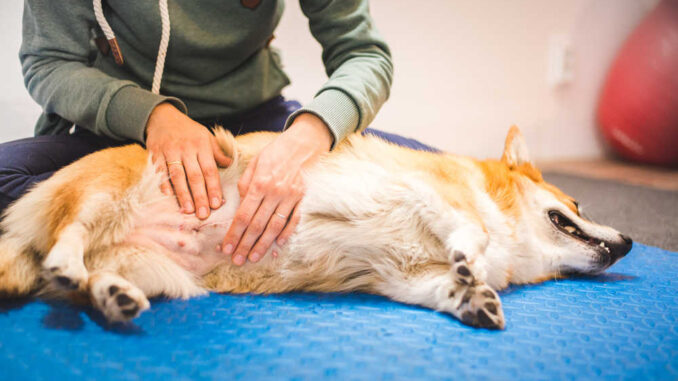
This article was updated on July 27th, 2023
It’s always a concern to find a new lump, bump, or sore on your dog’s belly, and your mind may jump to conclusions. There are a huge range of conditions we see that can cause a bump or sores to form on a dog’s abdomen, and most cases are benign and will resolve quickly.
The most common reason an owner will bring their dog to our veterinary practice is because of a skin issue, which can include pimples and bumps on the belly. This article will discuss the most common causes of these new lesions and help you decide on the next best steps.
Related post: if your dog’s bumps on the belly are small and red or pink, read our article: Red Spots on My Dog’s Belly.
Dog’s belly skin troubles: lumps, bumps, pimples & sores
Bumps, lumps and pimples on the belly are usually picked up by an owner when they’re giving their dog a tummy rub, or when bathing them. Sometimes, the lumps and bumps are noticed by a vet or groomer, as they take a close look at your pet and their skin.
As it can be tricky to spot new growths and lesions on longer furred dogs, it is a good idea to get into the habit of checking them all over regularly.
Finding a new lesion does not mean any one thing in particular. Indeed, there are a myriad of potential causes and, as the vet, we need to put our detective hats on to try and get to the bottom of things.
Top causes of lumps and bumps on a dog’s belly
1. Allergic skin disease
Certain dogs will be much more prone to pimples or red bumps on their skin, and this is especially true of those with allergies. Dogs with atopic skin disease tend to itch, rub and chew at their skin. The skin can be red, bald and broken. Not uncommonly, we also see pimples and pustules due to bacterial infections.
As well as on their belly, they can show signs on places like their paws and face. The picture below is an example of quite severe skin disease secondary to allergies and, at this stage, there is a secondary bacterial infection present:
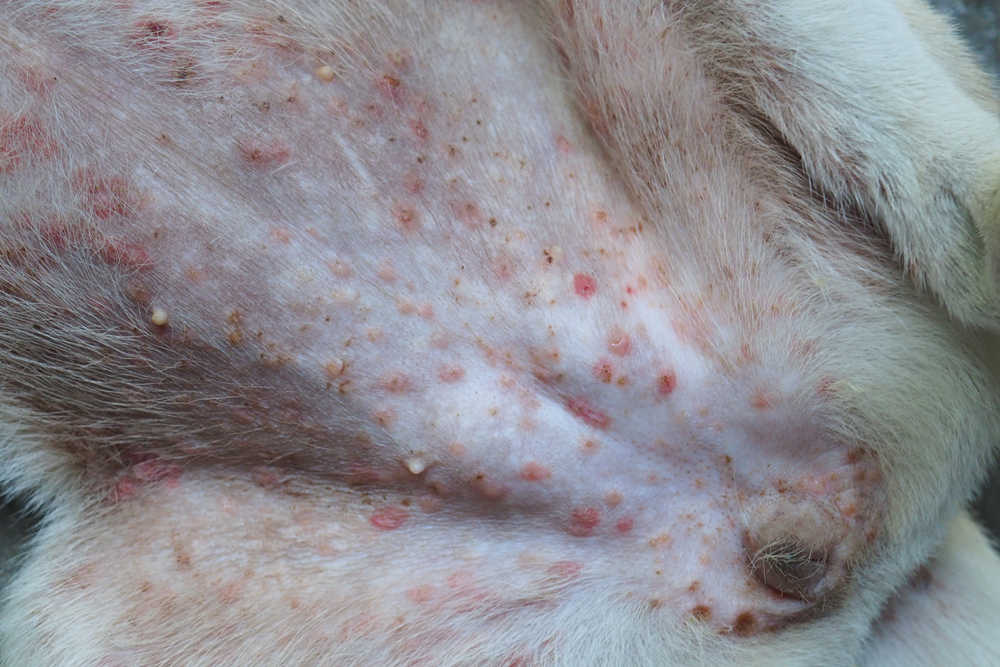
We can see that there are raised and crusted lesions and some pustules are also visible in the photo; containing yellow ooze. This dog is likely incredibly itchy.
Those with allergies can react to a range of things including ingredients in their foods, pollen, grasses and moulds. Allergies typically manifest between the ages of 1 and 3 and pedigree dogs including the Frenchie, Labrador and Pug are over-represented.
Food allergies can also lead to gastrointestinal issues such as diarrhea. To diagnose a food allergy, your veterinarian will have you feed either a nonallergenic, hydrolyzed or a novel protein diet to your dog for at least eight weeks.
Costs to diagnose and treat skin allergies will include treating the itching and any skin infection that may be present. This usually means some steroids to stop the itch and a course of antibiotics. The costs will range from $100-$300, depending on the size of the dog. However, it is expected for allergic dogs to experience flare ups throughout their lives, which need to be budgeted for.
When a dog has allergies, the aim is to avoid the allergens as much as possible, and to minimize any flare ups. Immunotherapy could be an option for some patients. View more pictures of dog skin allergies (with veterinarian advice).
2. A primary bacterial infection.
Skin infections can cause pimples and bumps on the dog’s belly that will feel raised. While infections tend to be itchy, this is not always the case. In a puppy, pyoderma typically occurs on the tummy. It is often the bacteria Staphylococcus that is involved.
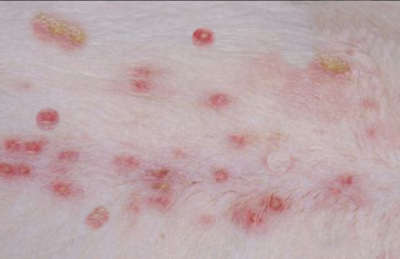
In the photo above we can see the classic pustules and papules that are associated with a pyoderma. Treatment usually consists of a medicated wash containing Chlorhexidine and a course of antibiotics that should last a few weeks. Stopping antibiotics too soon can mean the infection does not fully resolve. Cost of treatment ranges from about $150-300, depending on the size of the dog. Learn more about common skin infections in dogs.
3. Nipples.
While it may seem strange to include a section on nipples, I frequently meet owners who are concerned about their dog because they have found some raised pink or red lumps on their dog’s abdomen. Many owners of male dogs mistakenly think that males should not have nipples.
Nipples remain small throughout a dog’s life and should not be inflamed or crusty. If we go searching, we can usually find about 8 or 10 and they should be relatively symmetrically placed on the stomach.
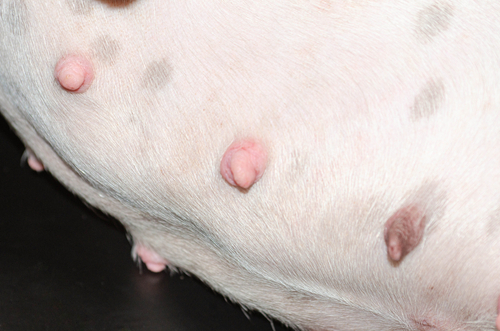
A female’s nipples will naturally enlarge while pregnant or lactating, or after her season, during a false pregnancy.
A single red or pink lump on a dog’s belly could be a growth such as a skin tag or wart, or may be a tumour. Any new growth should be checked over by a vet, especially if it has been present for more than two weeks or if it is growing rapidly.
A vet should analyze a new growth, if concerned it could be cancerous. This may mean a Fine Needle Aspirate (FNA) or biopsy. A biopsy ensures a larger sample is taken for analysis, but the dog may need a stitch or two after and this is generally done under anesthetic.
Other common skin rashes or irritation on dog’s bellies
Of course, not every change to the belly skin will be a growth. Oftentimes, we are dealing with flat rashes or changes to the skin color.
1. Acute moist dermatitis/ hot spots
Dogs can develop these bacterial infections anywhere on the body, including the stomach. The skin tends to be hot, red and oozing.
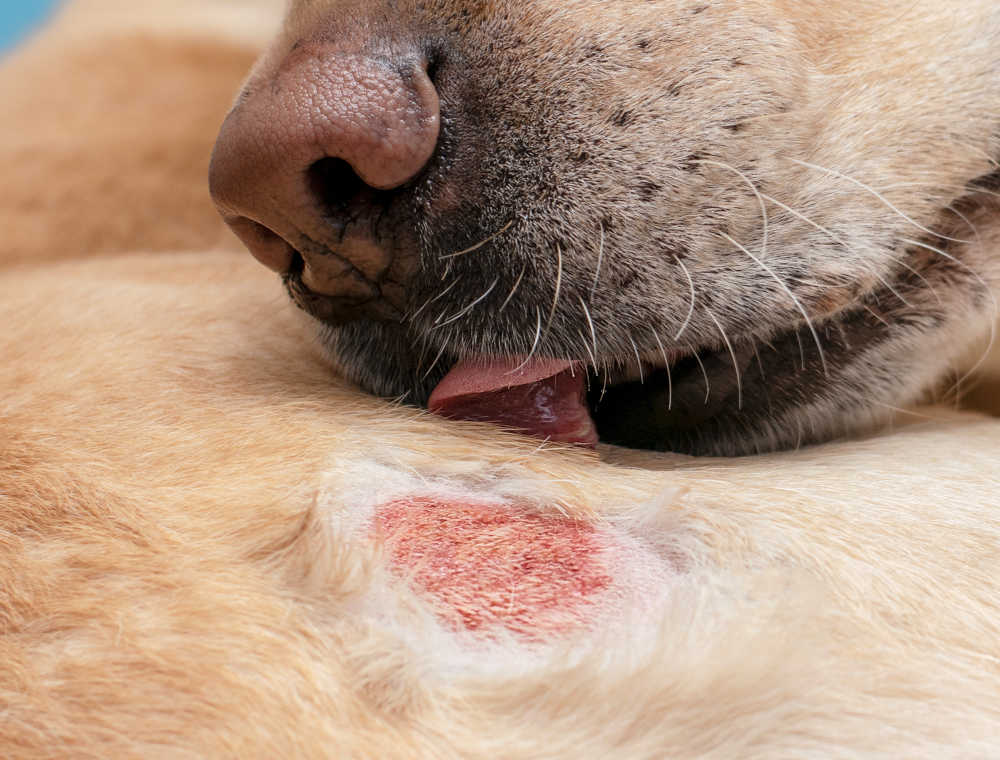
Treatment consists of clipping the fur and bathing the skin with a medicated wash, as well as some antibiotics and anti inflammatories. This can cost anywhere from $100-500. View more pictures of hot spots on dogs with veterinarian advice.
2. Fungal infections
Ringworm is a common fungal infection we see in our pet pooches and it can present as a flat, circular red lesion. The skin is typically dry and crusty. Most dogs will not be itchy.
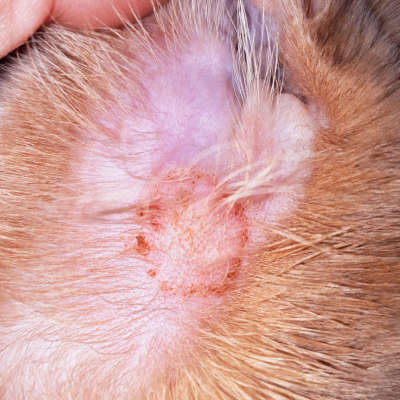
As ringworm can be passed to people, we need to be especially cautious here. Vets will diagnose ringworm by taking a fur pluck and also checking if the lesion glows under a Wood’s lamp. Treatment typically consists of medicated washes and topical or oral antifungals. Total treatment cost is about $200 or so. Learn more about skin infections in dogs.
3. Mange
Mange causes intense itching, fur loss and red skin. Mange is highly infectious between dogs so if one pup in the litter is affected, the rest will likely soon follow. The cause is tiny mites, which are only visible under the microscope.
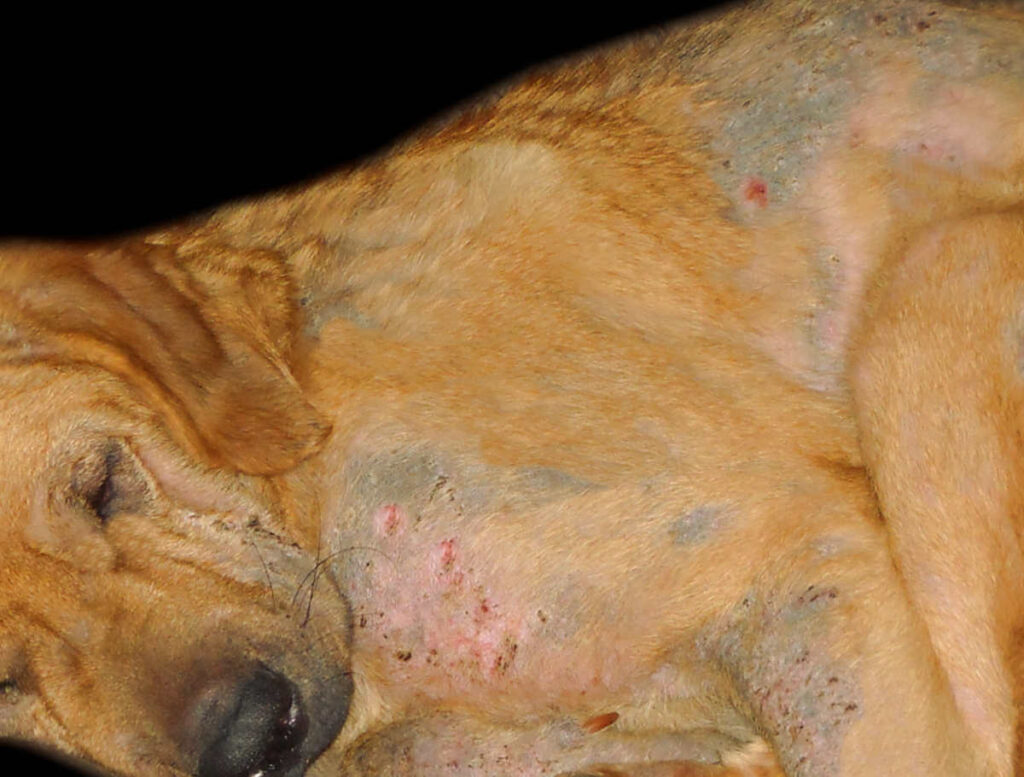
Mange can be treated with prescription washes like Amitraz, as well as strong oral products such as Bravecto or Nexgard Spectra. Some dogs need several washes, which have to be done in the vet clinic. For this reason, we could be looking at a final bill of about $500. Learn more about what dog mange (scabies) look like.
What to do when you find a lump or bump on your dog’s stomach
Any new lump or bump on the belly is worth noting down. If it is not going away quickly (within a few weeks) book your pet in for a check-up. It is useful to take a photo of the new growth beside a coin or ruler, so you can assess if it is growing or shrinking over the coming days.
When your dog’s belly bumps, lumps or pimples need veterinary help
If your dog is itchy or uncomfortable, they need to be seen ASAP. The quicker we treat skin disease, the less risk of secondary infections and of ongoing discomfort.
We should also have a dog seen promptly if their skin disease is spreading or worsening.
Veterinary diagnosis
Your vet will take a medical history from you and will also perform a full physical exam. Depending on what is suspected, the vet might take some tests such as blood tests, skin scrapes, fur plucks and swabs.
A thorough workup is key when it comes to diagnosing skin issues on the belly, so we can know which treatment would be best.
Common veterinary treatments
A chlorhexidine based wash is often used for belly skin lumps, bumps and rashes. It helps to reduce bacteria and yeast levels and can be soothing on itchy skin.
Those with infections would need prescribed antibiotics or antifungal medication, and courses may need to last a few weeks, to ensure any infection has been eliminated.
For itchy dogs, anti itch medicine are issued to break the itch scratch cycles and allow the skin to settle. Your vet may also recommend a buster collar and claw trim, to prevent any further self trauma.
Disclaimer: This website's content is not a substitute for veterinary care. Always consult with your veterinarian for healthcare decisions. Read More.


My shiu tzhu (Sorry if spelled wrong)11 years old and has a wobbly balloon like Sack on her lower abdominal and its kinda large(for her size) it kinda swings back and forth as she walks or runs, but its not bothering her or painful. Do I leave it as its not hurting her?
Hi there and thank you for this question.
From your description, I’d wonder about a cyst but other possibilities here would include an abscess (bacterial infection), lipoma (fatty lump), or perhaps a tumour.
Often, if we are happy these growths are benign and not bothering the dog, we will leave them. This is especially true if slow growing and in a place where they will not impede mobility.
If never assessed by a vet, this would be my first step, to rule out anything sinister.
Any fluid inside could be drained for analysis. If a cyst, it would re-fill.
The vet may discuss removal if it is ulcerated, prone to infections, or if there is a chance it is cancerous.
“The information on this website is not a substitute for in-person veterinary care. Always seek advice from your veterinarian if you have concerns about your pet’s medical condition.”